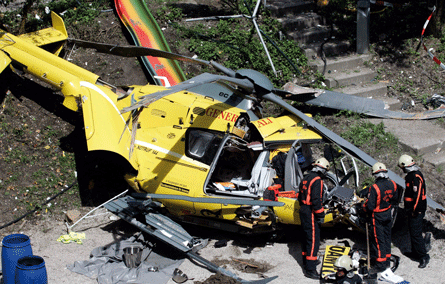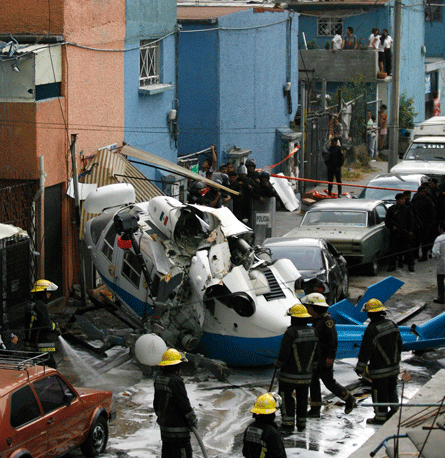The number of helicoper accidents worldwide has scarcely come down for the past 20 years. But could the findings of a new study show a way of improving safety?
Global helicopter safety is at a level well below where it should be. According to data, helicopter accident numbers have been more or less static worldwide for 20 years.
Two years ago, delegates at the inaugural meeting of the International Helicopter Safety Symposium (IHSS) in Montreal decided to do something about it.
Helicopter operators worldwide have a lot in common. They have the same kinds of accidents for the same reasons, often avoidably, according to an analysis just completed by the International Helicopter Safety Team (IHST), formed after that first meeting in Canada.
President of the US-based Helicopter Association International (HAI) Matt Zuccaro has seen the analysis and the individual accident reports on which it is based. "When I look at most of these reports, my frustration level goes through the roof. These accidents are preventable," he said at this year's International Helicopter Safety Symposium (IHSS), held on 19-21 September in Montreal. The HAI is integrated into the IHST effort.
Launched in 2005, the IHST was set up to address safety by analysing thousands of helicopter accident reports in detail, establishing patterns and common contributory factors, and developing strategies for safety performance improvement based strictly on the data.
For example, the IHST's US Joint Helicopter Safety Analysis Team (JHSAT), which has just reported its initial findings, has established that the operational category in which the most helicopter accidents occur is training, while the most commonly cited contributory factor in accident reports for almost all of the 15 categories identified is "pilot judgement and actions". The reaction from the rest of the world so far is that, although there may be regional variations related to the kind of work helicopters do, the US results echo their own experience.

IHST co-chairman and US Federal Aviation Administration regional manager, helicopter directorate, Dave Downey admits the findings will not surprise industry veterans. But the difference between received wisdom or anecdotal evidence and hard data is important: no-one can argue with hard facts. So the belief is that, if there are any operators who are in a state of denial that the helicopter industry's safety performance can easily be improved, the evidence might shake them out of their complacency.
|
|---|
This emergency medical services helicopter crashed near Salzburg, Austria in May 2006 |
Borrowed methodology
The IHST modelled its methodology on the system developed by the US Commercial Aviation Safety Team which, working with regional counterparts worldwide over the last decade, has dramatically reduced airline accident rates.
The JHSAT work has begun in the USA, but similar projects are already under way in other parts of the world. Regional safety analysis teams are already operating or being set up around the globe, notably in Canada, Europe, India, Japan, Australia and New Zealand, with others set to follow. The European Helicopter Safety Team (EHEST), for example, is already assembling data. According to Marieke Van Hijum of the European Aviation Safety Agency's safety analysis and research department - who is also on the EHEST - it expects to begin data analysis within about six months.
The JHSATs will be partnered by Joint Helicopter Safety Implementation Teams (JHSIT), whose task will be to put into place safety improvement strategies based on the analysis findings. Implementing these measures will lead to an 80% cut in helicopter accident rates by 2016, according to the IHST.
Having set itself a formidable goal, the IHST had to find somewhere to start. The US JHSAT has moved first, working for 16 months on the gathered material and reporting its findings at the safety symposium in September. The findings, at first glance, are a humble start.
The US JHSAT was reporting on accident data relating to the year 2000, but it has drilled deep into the detailed findings on 197 accidents involving US-registered helicopters in that 12-month period. These were the accident reports considered sufficiently comprehensive to provide the team with a spread of usable data. The year 2000 was chosen as a start because all the reports are complete, and all litigation relating to the accidents is history.
Now that the US JHSAT has handed its report to the JHSIT, it is already embarked on repeating the process for 2001 accidents, and the work will continue. It will, the team says, be simpler than the first study, because methods are established, and the datum from which to work has been set up in the 2000 study. From now on, the analysis will be able to validate the general lessons learned from the 2000 study, and to detect trends as each year's clutch of data is added to the database.
The US JHSAT consists of about 20 people whose employers - mainly helicopter manufacturers and the FAA - release them for one week a month, also funding travel and accomodation, to attend the latest JHSAT meeting.
So far they have produced the first analysis of one year's accidents in one country - albeit the nation in which half of all the world's civil helicopters operate.
The IHST ackowledges that regional JHSAT resources in other parts of the world - particularly those where no helicopter manufacturers are based - could be difficult to find and fund. But the manufacturers say they are committed to playing their part in a team effort. As Zuccaro says, the reputation of helicopters for safety (or the lack of it) is limiting the industry's growth for manufacturers and operators alike. In India for example, according to Somen Chowdhury, research manager at Bell Helicopter Textron Canada in Mirabel, it looks as if most of the regional JHSAT staff will come from operators, the regulator and Hindustan Aeronautics. Chowdhury conceived the ideas that culminated in the IHST, and is on the team's executive committee.
So what detail has emerged from the US JHSAT? Firstly, the main targets are small US helicopter operators with fleets of one to five machines. They are at once the USA's single largest rotary-wing operating resource, the main committers of mistakes, potentially the main beneficiaries of improved operating policies, and finally the most difficult companies to deal with because they do not have the spare resources for activities like risk analysis or communication with the wider industry.
The US JHSAT found that "pilot judgement and actions" is a factor in nearly 80% of all accidents. The JHSAT breaks that down into multiple subsections, but failure to follow procedure is its single biggest category.
Second on the list (see chart left) is what the JHSAT calls "data issues". Almost no US helicopters are equipped with flight data recorders, operational data monitoring, or health and usage monitoring systems, so there is a serious dearth of data following an accident.
Next in the US JHSAT's list of problem issues comes lack of an organisational safety culture, then "ground duties" and pilot situational awareness. All these issues are listed according to how often they are cited as factors in accident reports. Only after these human or organisational issues have caused most of the accidents, according to the JHSAT, do maintenance, engine or systems failure and other factors enter the equation.
As for the categories of operation that have the most accidents, the top five by a fair margin are (from the highest proportion of accidents downward): instructional flying "personal and private" flying aerial application operations emergency medical services and "commercial services", not including air tours or sightseeing flights.
Risk assessment
What, then, is the JHSIT's proposed solution? Operators, it says, need to set up a risk assessment system and manage their organisation accordingly. Given that the definition of the USA's main target audience is a group of independently minded small operators, the JHSAT is hesitant to state that there is a requirement for all of them to have a safety management system (SMS) because the terminology sounds intimidating and bureaucratic.
|
|---|
Everyone survived this March 2007 corporate helicopter accident in Mexico City |
Downey and the team are at pains to point out that an SMS is scaleable. It is a small but essential task for a small operator, and the potential benefits to the bottom line for those who toe the SMS line are many. The JHSIT has put together guidance material to help small operators set up an SMS easily, and to make a business case for it. The potential benefits are lower insurance premiums, no business losses due to lost or out-of-service aircraft or employees and no loss of customers through loss of confidence.
The lack of an organisational safety culture was cited as a factor in 47% of all US civil helicopter accidents in 2000. A safety management system in which the operator's owner or chief executive manifestly believes is a safety culture, the FAA says. And it cannot exist without a just culture - an internal, voluntary no-blame reporting system designed to flag up mistakes and practices that could be improved.
Most accidents happen during training, and training is one of the JHSIT's favoured solutions for reducing accidents. The use of new low-cost simulators to replace risky airborne exercises, and to give pilots for the first time practice at handling emergency situations like loss of tail rotor effectiveness that cannot be safely induced in a real helicopter, are recommended (see box right).
Van Hejum puts the EHEST into context: "[It] is a part of the European Strategic Safety Initiative, an industry/regulators partnership for enhancing safety in Europe based on voluntary commitment, facilitated - not owned - by EASA and powered by industry." EHEST will have its own EHSAT and EHSIT. And it is committed to working in concert with the IHST.
So far the UK, France, Germany and Italy, which together account for 72% of the current European helicopter fleet, are on board, she says. When Norway, Switzerland and Spain joint this will rise to 89%, and the figure will grow as new countries join.
EHEST faces challenges beyond those the US JHSAT has to deal with. The most obvious is that accident reports are in multiple languages, and there are as many aviation authorities and accident investigation agencies as there are countries. The US teams have a relatively easy life: they have only the FAA and the National Transportation Safety Board to deal with, using one language.
The EHEST sees its main issues - not yet prioritised - as:
- pilot disorientation in flight during night operations or inadvertent entry into instrument meteorological conditions
- controlled flight into terrain
- wire strikes
- loss of separation or collision
- personal protection equipment and survivability
- design issues
- maintenance issues.
The EHEST comments that "human factors and training are not explicitly listed, but play an essential role in most of these issues". That sounds familiar, as do all of the listed components - the US JHSAT report names all of them as it drills down into the detail.
The US JHSAT's analysis may only be confined to one year so far, but it is massively detailed. It is the first step down the road to getting helicopter safety under control, which most of the global airline industry and some of the world's major helicopter operators have already done. Meanwhile there are detailed research projects ongoing into specialist infrastructural areas like offshore helideck lighting (see box). The opportunities for improvement are there, the resolve is tangible, and the objective is clearly achievable.
Source: Flight International


















